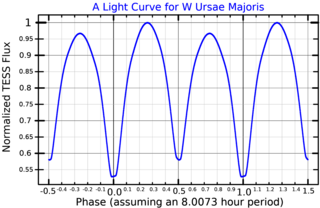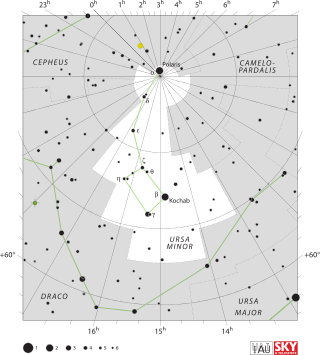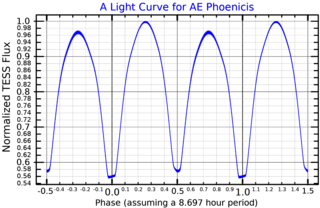
W Ursae Majoris is the variable star designation for a binary star system in the northern constellation of Ursa Major. It has an apparent visual magnitude of about 7.9, which is too faint to be seen with the naked eye. However, it can be viewed with a small telescope. Parallax measurements place it at a distance of roughly 169 light years (52 parsecs) from Earth.

Eta Ursae Minoris is a yellow-white hued star in the northern circumpolar constellation of Ursa Minor.
Pi1 Ursae Minoris is a common proper motion binary star system in the northern circumpolar constellation of Ursa Minor. The pair have apparent visual magnitudes of +6.58 and +7.31, with a combined magnitude of 6.1. They are located about 71 light years from the Sun. The two have an angular separation of 31.4 arc seconds, which corresponds to a physical separation of about 680 AU, and orbit each other with a period of about 13,100 years.
Pi2 Ursae Minoris, which is Latinized from π2 UMi Ursae Minoris, is a binary star system in the northern circumpolar constellation of Ursa Minor. The pair have a combined apparent visual magnitude of 6.89, which can be viewed with a pair of binoculars. They are located at a distance of approximately 400 light years from the Sun based on parallax, but are drifting closer with a radial velocity of −32 km/s.
14 Boötis is a possible binary star system located 110 light years away from the Sun in the northern constellation of Boötes. It is visible to the naked eye as a dim, yellow-white hued star with a combined apparent visual magnitude of 5.53. This system is moving closer to the Earth with a heliocentric radial velocity of −40 km/s. It has a relatively high proper motion, traversing the celestial sphere at the rate of 0.260 arc seconds per annum.

Epsilon Canis Minoris is a suspected binary star system in the equatorial constellation of Canis Minor. It is a fifth magnitude star, which means it is bright enough to be faintly visible to the naked eye. Based upon an annual parallax shift of just 3.13 mas as seen from Earth, this star is located roughly 770 light years from the Sun, give or take a 40 light year margin of error.

S Antliae is a W Ursae Majoris-type eclipsing binary star in Antlia.
11 Ursae Minoris is a single star located approximately 410 light years away in the northern circumpolar constellation of Ursa Minor. The star is visible to the naked eye as a faint, orange-hued star with an apparent visual magnitude of 5.15. It is moving closer to the Earth with a heliocentric radial velocity of −17.5 km/s.
27 Hydrae is a member of a triple star system system in the equatorial constellation of Hydra, located 222 light years away from the Sun. It is visible to the naked eye as a faint, orange-hued star with a combined apparent visual magnitude of 4.82. The system is moving further from the Earth with a heliocentric radial velocity of +25.6 km/s.

Epsilon Sagittae (ε Sagittae) is a solitary, yellow-hued star in the northern constellation of Sagitta. With an apparent visual magnitude of +5.64 to +5.67, it is faintly visible to the naked eye on a dark night. It is a variable star with a small amplitude of 0.03 magnitudes. Based upon an annual parallax shift of 5.60 mas as seen from Earth, it is located roughly 580 light years from the Sun. At that distance, the visual magnitude of the star is diminished by an extinction factor of 0.1 due to interstellar dust.

12 Comae Berenices is a binary star system in the northern constellation of Coma Berenices. It is the brightest member of the Coma Cluster and is visible to the naked eye with an apparent visual magnitude of 4.80. Although listed as a suspected variable star, there is no photometric evidence of it being variable in luminosity. However, the radial velocity was found to be variable, as announced by W. W. Campbell in 1910. The first orbital solution was published by Vinter Hansen in the 1940s. It is a double-lined spectroscopic binary with an orbital period of 396.5 days and an eccentricity of 0.566.

Zeta Crateris is a probable binary star system in the southern constellation of Crater. Zeta Crateris appears to be about half-way between Epsilon Corvi to the southeast and Beta Crateris to the northwest, and marks the lower left corner of the rim of the bowl. Eta Crateris lies somewhat less than half of the way from Zeta Crateris to Gamma Corvi, the bright star above, (north) of Epsilon Corvi.

HR 4072 is a binary star system in the northern circumpolar constellation of Ursa Major. It has the variable star designation ET Ursae Majoris, abbreviated ET Uma, while HR 4072 is the system's designation from the Bright Star Catalogue. It has a white hue and is faintly visible to the naked eye with an apparent visual magnitude that fluctuates around 4.94. The system is located at a distance of approximately 339 light years from the Sun based on parallax measurements. The radial velocity measurement is poorly constrained, but it appears to be drifting closer to the Sun at the rate of around −3 km/s.

RR Ursae Minoris, abbreviated RR UMi, is a binary star system in the northern circumpolar constellation of Ursa Minor. It can be viewed with the naked eye, typically having an apparent visual magnitude of around 4.710. Based upon an annual parallax shift of 10.0 mas as seen from Earth's orbit, it is located 330 light years away. The system is moving further from the Sun with a heliocentric radial velocity of +6 km/s.
4 Ursae Minoris is a binary star system in the northern circumpolar constellation Ursa Minor. It is faintly visible to the naked eye with an apparent visual magnitude of 4.80. Based upon an annual parallax shift of 7.14±0.42 mas as seen from Earth's orbit, it is located roughly 460 light years from the Sun. It is moving further away with a heliocentric radial velocity of +5.9 km/s.
π2 Gruis, Latinised as Pi2 Gruis, is a binary star system in the southern constellation of Grus. It is faintly visible to the naked eye as a yellow-white hued star with an apparent visual magnitude of 5.622. Based upon an annual parallax shift of 25.1 mas as seen from the Earth, the system is located 130 light years from the Sun.

T Ursae Minoris is a variable star in the constellation Ursa Minor, located 2′30″ west-southwest of 3 Ursae Minoris toward the western border of the constellation with Draco.

AE Phoenicis is a variable star in the constellation of Phoenix. An eclipsing binary, its apparent magnitude has a maximum of 7.56, dimming to 8.25 during primary eclipse and 8.19 during secondary eclipse. From parallax measurements by the Gaia spacecraft, the system is located at a distance of 168 light-years from Earth.

V752 Centauri is multiple star system and variable star in the constellation of Centaurus. An eclipsing binary, its apparent magnitude has a maximum of 9.10, dimming to 9.66 during primary eclipse and 9.61 during secondary eclipse. Its variability was discovered by Howard Bond in 1970. From parallax measurements by the Gaia spacecraft, the system is located at a distance of 410 light-years from Earth.

RZ Leonis Minoris is a cataclysmic variable star system in the northern constellation of Leo Minor. It undergoes frequent outbursts that vary in brightness from an apparent visual magnitude of 14.4 down to 16.8. Based on parallax measurements, this system is located at a distance of approximately 2,160 light years from the Sun.













